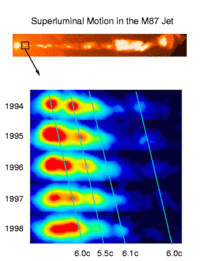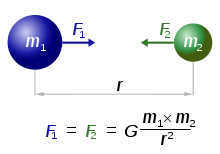Energy phantoms/Lecture
< Energy phantoms
An energy phantom is an observational phenomenon that can be described in general terms of distances and times.
In the images at right are the effects of charged particles apparently moving six times the speed of light.
"We see almost a dozen clouds which appear to be moving out from the galaxy's center at between four and six times the speed of light. These are all located in a narrow [relativistic] jet of gas streaming out from the region of the black hole at the galaxy's center".[1]
"We believe this apparent speed translates into an actual velocity just slightly below that of light itself."[1]
"The speeds reported are two to three times faster than the fastest motions previously recorded in M87, the only nearby galaxy to show evidence for superluminal motion."[1]
"This discovery goes a long way towards confirming that radio galaxies, quasars and exotic BL Lac objects are basically the same beast, powered by super massive black holes, and differ only in orientation with respect to the observer".[1]
"Here we have, for the first time, a fairly normal radio galaxy with both excellent evidence for a super-massive black hole, as well as superluminal jet speeds similar to those seen in distant quasars and BL Lac objects."[1]
"This is the first time superluminal motion has been seen with any optical telescope, and this discovery was made possible by the extremely fine resolution obtained by Hubble".[2]
"The structure of relativistic jets in [active galactic nuclei] AGN on scales of light days reveals how energy propagates through jets, a process that is fundamental to galaxy evolution."[3]
Energies
Def. a "quantity that denotes the ability to do work and is measured in a unit dimensioned in mass × distance²/time² (ML²/T²) or the equivalent"[4] is called energy.
Def. "[a] physical quantity that denotes ability to push, pull, twist or accelerate a body which is measured in a unit dimensioned in mass × distance/time² (ML/T²): SI: newton (N); CGS: dyne (dyn)"[5] is called force.
In astronomy we estimate distances and times when and where possible to obtain forces and energy.
The key values to determine in both force and energy are (L/T²) and (L²/T²). Force (F) x distance (L) = energy (E), L/T² x L = L²/T². Force and energy are related to distance and time using proportionality constants.
Every point mass attracts every single other point mass by a force pointing along the line intersecting both points. The force is proportional to the product of the two masses and inversely proportional to the square of the distance between them:[6]  ,
,
where:
- F is the force between the masses,
- G is the gravitational constant,
- m1 is the first mass,
- m2 is the second mass, and
- r is the distance between the centers of the masses.
 The diagram shows two masses attracting one another. Credit: .
The diagram shows two masses attracting one another. Credit: .
In the International System of Units (SI) units, F is measured in newtons (N), m1 and m2 in kilograms (kg), r in meters (m), and the constant G is approximately equal to 6.674×10−11
N m2 kg−2.[7]
Observationally, we may not know the origin of the force.
Coulomb's law states that the electrostatic force  experienced by a charge,
experienced by a charge,  at position
at position  , in the vicinity of another charge,
, in the vicinity of another charge,  at position
at position  , in vacuum is equal to:
, in vacuum is equal to:
where  is the electric constant and
is the electric constant and  is the distance between the two charges.
is the distance between the two charges.
Coulomb's constant is
where the constant  is called the permittivity of free space in SI units of C2 m−2 N−1.
is called the permittivity of free space in SI units of C2 m−2 N−1.
For reality,  is the relative (dimensionless) permittivity of the substance in which the charges may exist.
is the relative (dimensionless) permittivity of the substance in which the charges may exist.
The energy  for this system is
for this system is
where  is the displacement.
is the displacement.
Unknown forces
Newton's second law of motion is that  , where
, where  is the force applied,
is the force applied,  is the mass of the object receiving the force, and
is the mass of the object receiving the force, and  is the acceleration observed for the astronomical object. The newton is therefore:[8]
is the acceleration observed for the astronomical object. The newton is therefore:[8]
where:
- N: newton
- kg: kilogram
- m: metre
- s: second.
In dimensional analysis:
where
- M: mass
- L: length
- T: time.
But, for a force of unknown type, mass or charge may be meaningless until proven applicable.
So that
and
where  may be called an energy phantom, or astronomical energy phantom.
may be called an energy phantom, or astronomical energy phantom.
Research
Hypothesis:
- Positive and negative effective mass may be a representation of a electromagnetic type interaction that produces all four fundamental interactions.
Control groups

The findings demonstrate a statistically systematic change from the status quo or the control group.
“In the design of experiments, treatments [or special properties or characteristics] are applied to [or observed in] experimental units in the treatment group(s).[9] In comparative experiments, members of the complementary group, the control group, receive either no treatment or a standard treatment.[10]"[11]
Proof of concept
Def. a “short and/or incomplete realization of a certain method or idea to demonstrate its feasibility"[12] is called a proof of concept.
Def. evidence that demonstrates that a concept is possible is called proof of concept.
The proof-of-concept structure consists of
- background,
- procedures,
- findings, and
- interpretation.[13]
See also
- Energy phantoms, a laboratory.
References
- 1 2 3 4 5 John Biretta (January 6, 1999). "Hubble Detects Faster-Than-Light Motion in Galaxy M87". Baltimore. Maryland USA: Space Telecsope Science Institute. Retrieved 2013-04-28.
- ↑ Duccio Macchetto (January 6, 1999). "Hubble Detects Faster-Than-Light Motion in Galaxy M87". Baltimore. Maryland USA: Space Telecsope Science Institute. Retrieved 2013-04-28.
- ↑ Ann E. Wehrle, Norbert Zacharias, Kenneth Johnston, David Boboltz, Alan L. Fey, Ralph Gaume, Roopesh Ojha, David L. Meier, David W. Murphy, Dayton L. Jones, Stephen C. Unwin, B. Glenn Piner (February 11, 2009). What is the structure of Relativistic Jets in AGN on Scales of Light Days? In: Galaxies Across Cosmic Time. http://www.nrao.edu/A2010/whitepapers/rac/Wehrle_AGN_jets_GCT.pdf. Retrieved 2013-04-28.
- ↑ "energy, In: Wiktionary". San Francisco, California: Wikimedia Foundation, Inc. July 12, 2013. Retrieved 2013-07-14.
- ↑ "force, In: Wiktionary". San Francisco, California: Wikimedia Foundation, Inc. September 1, 2011. Retrieved 2013-12-04.
- ↑ - Proposition 75, Theorem 35: p.956 - I.Bernard Cohen and Anne Whitman, translators: Isaac Newton, The Principia: Mathematical Principles of Natural Philosophy. Preceded by A Guide to Newton's Principia, by I.Bernard Cohen. University of California Press 1999 ISBN 0-520-08816-6 ISBN 0-520-08817-4
- ↑ "CODATA2006".
- ↑ "Table 3. Coherent derived units in the SI with special names and symbols, In: The International System of Units (SI)". International Bureau of Weights and Measures. 2006.
- ↑ Klaus Hinkelmann, Oscar Kempthorne (2008). Design and Analysis of Experiments, Volume I: Introduction to Experimental Design (2nd ed.). Wiley. ISBN 978-0-471-72756-9. http://books.google.com/?id=T3wWj2kVYZgC&printsec=frontcover.
- ↑ R. A. Bailey (2008). Design of comparative experiments. Cambridge University Press. ISBN 978-0-521-68357-9. http://www.cambridge.org/uk/catalogue/catalogue.asp?isbn=9780521683579.
- ↑ "Treatment and control groups, In: Wikipedia". San Francisco, California: Wikimedia Foundation, Inc. May 18, 2012. Retrieved 2012-05-31.
- ↑ "proof of concept, In: Wiktionary". San Francisco, California: Wikimedia Foundation, Inc. November 10, 2012. Retrieved 2013-01-13.
- ↑ Ginger Lehrman and Ian B Hogue, Sarah Palmer, Cheryl Jennings, Celsa A Spina, Ann Wiegand, Alan L Landay, Robert W Coombs, Douglas D Richman, John W Mellors, John M Coffin, Ronald J Bosch, David M Margolis (August 13, 2005). "Depletion of latent HIV-1 infection in vivo: a proof-of-concept study". Lancet 366 (9485): 549-55. doi:10.1016/S0140-6736(05)67098-5. http://www.ncbi.nlm.nih.gov/pmc/articles/PMC1894952/. Retrieved 2012-05-09.
External links
| ||||||||||||||||||||||||||||||||
| ||||||||||||||||||||||||||||||||||||||
![]() This is a research project at http://en.wikiversity.org
This is a research project at http://en.wikiversity.org
| |
Development status: this resource is experimental in nature. |
| |
Educational level: this is a research resource. |
| |
Resource type: this resource is an article. |
| |
Resource type: this resource contains a lecture or lecture notes. |
| |
Subject classification: this is an astronomy resource. |








